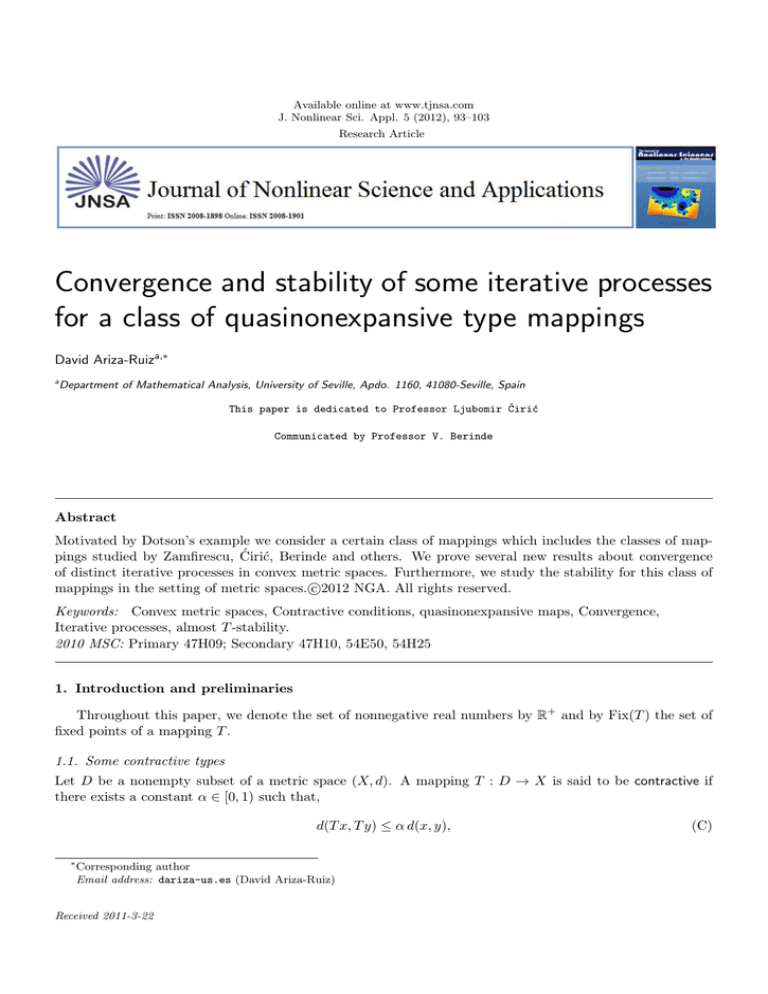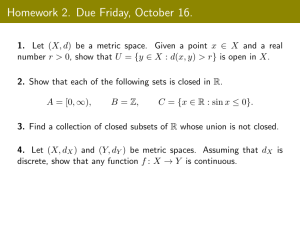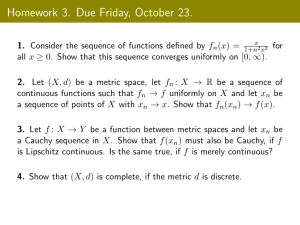
Available online at www.tjnsa.com
J. Nonlinear Sci. Appl. 5 (2012), 93–103
Research Article
Convergence and stability of some iterative processes
for a class of quasinonexpansive type mappings
David Ariza-Ruiza,∗
a
Department of Mathematical Analysis, University of Seville, Apdo. 1160, 41080-Seville, Spain
This paper is dedicated to Professor Ljubomir Ćirić
Communicated by Professor V. Berinde
Abstract
Motivated by Dotson’s example we consider a certain class of mappings which includes the classes of mappings studied by Zamfirescu, Ćirić, Berinde and others. We prove several new results about convergence
of distinct iterative processes in convex metric spaces. Furthermore, we study the stability for this class of
c
mappings in the setting of metric spaces.2012
NGA. All rights reserved.
Keywords: Convex metric spaces, Contractive conditions, quasinonexpansive maps, Convergence,
Iterative processes, almost T -stability.
2010 MSC: Primary 47H09; Secondary 47H10, 54E50, 54H25
1. Introduction and preliminaries
Throughout this paper, we denote the set of nonnegative real numbers by R+ and by Fix(T ) the set of
fixed points of a mapping T .
1.1. Some contractive types
Let D be a nonempty subset of a metric space (X, d). A mapping T : D → X is said to be contractive if
there exists a constant α ∈ [0, 1) such that,
d(T x, T y) ≤ α d(x, y),
∗
Corresponding author
Email address: dariza-us.es (David Ariza-Ruiz)
Received 2011-3-22
(C)
Ariza-Ruiz, J. Nonlinear Sci. Appl. 5 (2012), 93–103
94
for all x, y ∈ D. The well known Banach’s fixed point theorem asserts that if D = X, T is contractive and
(X, d) is complete, then T has a unique fixed point p in X, and for any x0 ∈ X the sequence {T n (x0 )}
converges to p. This result has been extended by several authors to some classes of mappings by changing
the contractive condition (C). For instance, two conditions that can replace (C) in Banach’s theorem are
the following:
• (Kannan, [25]) There exists κ ∈ [0, 1) such that, for all x, y ∈ D,
d(T x, T y) ≤
κ
[d(x, T x) + d(y, T y)] .
2
(K)
• (Chatterjea [5]) There exists ξ ∈ [0, 1) such that, for all x, y ∈ D,
d(T x, T y) ≤
ξ
[d(x, T y) + d(y, T x)] .
2
(Ch)
The conditions (C), (K) and (Ch) are independent (see [1], [37] and [14]).
In 1972, Zamfirescu [41], combining the conditions (C), (K) and (Ch), obtained a fixed point theorem
for the class of mappings T : X → X for which there exists ζ ∈ [0, 1) such that
n
1
d(T x, T y) ≤ ζ max d(x, y), d(x, T x) + d(y, T y) ,
2
o
1
d(x, T y) + d(y, T x) .
2
(Z)
A mapping satisfying (Z) is commonly called a Zamfirescu mapping. Note that the class of Zamfirescu
mappings is a subclass of the class of mappings T satisfying the following condition: there exists 0 ≤ h < 1
such that
n
o
1
d(T x, T y) ≤ h max d(x, y), d(x, T x) + d(y, T y) , d(x, T y), d(y, T x) .
(R)
2
This condition was first considered by Ćirić [6] who obtained a fixed point theorem for mappings satisfying (R). Recently, this class of mappings has been studied by Rafiq [34]. Notice that every mapping T
satisfying (R) is a quasicontraction. The concept of quasicontraction was introduced and investigated by
Ćirić [7] in 1971, who obtained an existence fixed point theorem under the following condition: there exists
a constan q ∈ [0, 1) such that
n
o
d(T x, T y) ≤ q max d(x, y), d(x, T x), d(y, T y), d(x, T y), d(y, T x) .
(QC)
Recently, Berinde [2] proved a fixed point result using a new condition, which is independent of (QC). This
condition can be stated as follows: there exist two constants θ ∈ [0, 1) and L ≥ 0 such that
d(T x, T y) ≤ θ d(x, y) + L d(y, T x)
(B)
for all x, y ∈ D. To obtain the uniqueness of the fixed point of a mapping satisfying (B), Berinde considered
the following contractive condition, quite similar to (B). There exist two constants δ ∈ [0, 1) and L1 ≥ 0
such that
d(T x, T y) ≤ δ d(x, y) + L1 d(x, T x)
(B’)
for all x, y ∈ D.
Berinde noticed that the identity mapping on any metric space satisfies (B) but does not (B’). With the
following example, we prove that both classes of mappings are independent.
Ariza-Ruiz, J. Nonlinear Sci. Appl. 5 (2012), 93–103
95
Example 1.1. Let X = {a, b} be any set together with the discrete metric d. The mapping T : X → X,
given by T a = b and T b = a, satisfies (B’) with δ ∈ (0, 1) arbitrary and L1 ≥ 1 − δ. Indeed,
d(T a, T b) = 1 ≤ δ + L1 = δ d(a, b) + L1 d(a, b) = δ d(a, b) + L1 d(a, T a)
and, similarly,
d(T b, T a) = 1 ≤ δ + L1 = δ d(b, a) + L1 d(b, a) = δ d(b, a) + L1 d(b, T b).
Moreover, T does not satisfy (B), since if there exist θ ∈ [0, 1) and L ≥ 0 such that T verifiques (B), then
d(T a, T b) ≤ θ d(a, b) + L d(b, T a),
that is, 1 ≤ θ, which is a contradiction.
1.2. Convex metric spaces
Throughout this paper, we consider a type of metric spaces introduced by Takahashi [39] in 1970. This class
of metric spaces, called convex metric spaces, had been used to obtain some generalizations of fixed point
results on Banach spaces, for example, by Ćirić for non-self mappings [8, 9, 10, 11, 12, 13].
Definition 1.2. A convex metric space (X, d, ⊕) is a metric space (X, d) together with a convexity mapping
⊕ : X × X × [0, 1] → X satisfying
d(z, (1 − λ)x ⊕ λy) ≤ (1 − λ) d(z, x) + λ d(z, y),
(1.1)
for all x, y, z ∈ X, λ ∈ [0, 1].
Example 1.3. Obviously, any normed space is a convex metric space. Spaces of hyperbolic type, which
were introduced by Goebel and Kirk [18] are convex metric spaces. Hyperbolic spaces in the sense of Reich
and Safrir [35] are also convex metric spaces. Other examples of convex metric spaces are Busemann spaces,
CAT (0)-spaces, Hilbert ball and R-trees (For a deeper discussion we refer the reader to [27]).
Every convex metric space satisfies the following property, which is very important.
Proposition 1.4. If (X, d, ⊕) is a convex metric space, then
d(x, (1 − λ)x ⊕ λy) = λ d(x, y)
and
d(y, (1 − λ)x ⊕ λy) = (1 − λ) d(x, y),
for all x, y ∈ X and λ ∈ [0, 1].
As as immediate consequence, we obtain that 1x⊕0y = x, 0x⊕1y = y and (1−λ)x⊕λx = λx⊕(1−λ)x =
x.
A nonempty subset C of a convex metric space (X, d, ⊕) is said to be convex if (1 − λ)x ⊕ λy ∈ C for
all x, y ∈ C and λ ∈ [0, 1]. A nice feature of our setting is that any convex subset is itself a convex metric
space with the restriction of d and ⊕ to C.
1.3. Some iterative processes
Let D be a nonempty subset of a metric space (X, d) and T : D → D a self-mapping. Let x0 ∈ D be
fixed, we can consider the sequence {xn }n∈N defined by
xn+1 := T (xn ) = T n+1 (x0 ),
for all n ∈ N.
(1.2)
The sequence defined by (1.2) is known as the Picard iteration.
Let C be a closed subset of a complete metric space (X, d). If T : C → C satisfies any of the conditions (C), (K), (Ch), (Z), (R), (QC), (B), then T has at least a fixed point. Moreover, the Picard iteration
converges to a fixed point of T . However, if any of this conditions is slightly weaker, then the Picard iteration
need not converge to a fixed point of the operator T . The following trivial example shows this behavior.
Ariza-Ruiz, J. Nonlinear Sci. Appl. 5 (2012), 93–103
96
Example 1.5. Let X = {x1 , x2 , x3 }, with the discrete metric d, and T : X → X defined by T (x1 ) = x3 ,
T (x2 ) = x2 and T (x3 ) = x1 . It is easy to check that T is nonexpansive, that is, d(T xi , T xj ) ≤ d(xi , xj ) for
all i, j ∈ {1, 2, 3}. Moreover, the Picard iteration of T , with the starting point x1 or x3 , does not converge
to x2 , which is the fixed point of T .
In view of above example, we can state that some other iteration processes must be considered. Bearing
in mind the iterative processes that exist in the Banach space setting, we shall introduce the most important
iterative processes in the convex metric spaces. In order to do this, C will be a convex subset of a convex
metric space (X, d, ⊕) and T : C → C a mapping.
For any given x0 in C, the sequence {xn }n∈N defined by
xn+1 = (1 − λ)xn ⊕ λT xn ,
for all n ∈ N,
(1.3)
where λ ∈ (0, 1), is called Krasnosel’skij iteration [26].
Mann iteration [28] is essentially an averaged algorithm which generates a sequence recursively
xn+1 = (1 − αn )xn ⊕ αn T xn ,
for all n ∈ N,
(1.4)
where the initial guess x0 ∈ C and {αn }n∈N is a sequence in (0, 1).
Ishikawa iteration [23] is the following process of two steps: let x0 ∈ X be fixed, consider the sequence
{xn }n∈N defined by
yn = (1 − βn )xn ⊕ βn T xn ,
(1.5)
xn+1 = (1 − αn )xn ⊕ αn T yn ,
for all n ∈ N,
where {αn }n∈N and {βn }n∈N are sequence in [0, 1].
2. The class of ϕ-quasinonexpansive mappings
In 1970, Dotson [17] considered the following self-mapping T : R → R, defined by
x
if x 6= 0,
2 sin x1
Tx =
0
if x = 0.
He showed that T satisfies the following property
d(T x, p) ≤
1
d(x, p),
2
for all x ∈ R, p ∈ Fix(T ) = {0}. Thus, motivated by this example, we can consider the following class of
mappings.
Definition 2.1. Let D be a nonempty subset of a metric space (X, d). We say that T : D → X is a
ϕ-quasinonexpansive mapping if Fix(T ) 6= ∅ and there exists a function ϕ : R+ → R+ such that
d(T x, p) ≤ ϕ(d(x, p)),
for all x ∈ X, p ∈ Fix(T ).
(2.1)
Ariza-Ruiz, J. Nonlinear Sci. Appl. 5 (2012), 93–103
97
Recently, Olatinwo have studied intensively contractive conditions that includes as a particular case the
class of ϕ-nonexpansive mappings (see [29, 31] and many other papers by the same author).
Notice that if we take ϕ as the identity function, we obtain the concept of quasi-nonexpansiveness, which
was introduced by Tricomi [40] for real functions and later studied by Diaz and Metcalf [15], [16] and by
Dotson [17] for mappings in Banach spaces (see [3, Section 3.5, Section 4.2] for detailed discussion of this
and related notions.).
We now proceed to show that the mappings from Subsection 1.1 are in the class of ϕ-quasinonexpansive
mappings. One can easily show that every contractive mapping is a ϕ-quasinonexpansive mapping, with
ϕ(t) = α t for t ∈ R+ , using Banach’s fixed point theorem. However, Dotson’s example shows that the class
of ϕ-quasinonexpansive mappings properly includes contractive mappings. Moreover, this example can be
generalized in such a way that the resulting map is not contractive.
Example 2.2. Let ϕ : R+ → R+ be a function such that ϕ(t) < t for each t > 0. Let X be the real line
with the usual metric. The mapping T : R → R defined by
if x =
6 0,
ϕ(x) sin x1
Tx =
0
if x = 0,
is a ϕ-quasinonexpansive mapping but T is not a contractive mapping.
Example 2.5 in [3, Page 39] shows that Kannan mappings are also ϕ-quasinonexpansive mappings with
κ
ϕ(t) := 2−κ
t, for each t ∈ R+ . Using a similar argument, one can prove that every Chatterjea mapping is
a ϕ-quasinonexpansive mapping, with ϕ(t) = ξ t for t ∈ R+ . Thus, we can deduce that every Zamfirescu
mapping is a ϕ-quasinonexpansive mapping with ϕ(t) := ζ t, for each t ∈ R+ . The following result, which is
implicitly included in [3], shows that this fact is still true for a more general class of mappings.
Proposition 2.3. [3] Let (X, d) be a complete metric space. If T : X → X satisfies (QC), then T is a
q
ϕ-quasinonexpansive mapping, with ϕ(t) := max{q, 1−q
} t.
Proof. Ćirić [7] proved that T has a unique fixed point p in X. Taking y = p in (QC) we get
d(T x, p) = d(T x, T p)
n
o
≤ q max d(x, p), d(x, T x), d(p, T p), d(x, T p), d(p, T x)
n
o
≤ q max d(x, p), d(x, p) + d(p, T x), d(p, T x) ,
for each x in X. Since 0 ≤ q < 1, we deduce
n
o
q
d(T x, p) ≤ max q, 1−q d(x, p),
for every x ∈ X.
In the case of mappings satisfying (R), we can obtain a better function ϕ.
Proposition 2.4. [3] Let (X, d) be a complete metric space. If T : X → X satisfies (R), then T is a
ϕ-quasinonexpansive mapping, with ϕ(t) := h t.
Proof. By Ćirić [7], we know that T has a unique fixed point in X, say p. If we take y = p in (R) we get
d(T x, p) = d(T x, T p)
n
o
1
≤ h max d(x, p), d(x, T x) + d(p, T p) , d(x, T p), d(p, T x)
2
n
o
1
≤ h max d(x, p), d(x, p) + d(p, T x)
2
Ariza-Ruiz, J. Nonlinear Sci. Appl. 5 (2012), 93–103
98
for each x in X. Hence,
n
o
h
d(T x, p) ≤ max h, 2−h
d(x, p) = h d(x, p),
for every x ∈ X, because 0 ≤ h < 1.
A trivial verification shows that if T has at least one fixed point and satisfies (B’), then T is a ϕnonexpansive mapping, with ϕ(t) = δ t for each t ∈ R+ .
We must notice that there exist other classes of mappings which belong to the class of ϕ-quasinonexpansive
mappings. For example, Jaggi [24] proved the following fixed point theorem.
Theorem 2.5. Let T be a continuous selfmap defined on a complete metric space (X, d). Suppose that T
satisfies the following contractive condition:
d(T x, T y) ≤ α
d(x, T x) d(y, T y)
+ β d(x, y),
d(x, y)
(2.2)
for all x, y ∈ X, x 6= y, and for some α, β ∈ [0, 1) with α + β < 1, then T has a unique fixed point in X.
A trivial verification shows that if T satisfies the assumptions of Jaggi’s theorem, then T is a continuous
ϕ-quasinonexpansive mapping, with ϕ(t) := β t for each t ∈ R+ .
3. Convergence results
Here and subsequently, Φ denotes the family of functions ϕ : R+ → R+ such that ϕ is continuous and
ϕ(t) < t for all t > 0. Before we discuss our results, we state an elementary numerical result.
Lemma 3.1. Let {λn }n∈N be a real sequence in [0, 1] and let {dn }n∈N be a sequence of nonnegative real
numbers such that
dn+1 ≤ (1 − λn ) dn + λn ϕ(dn )
for all n ∈ N,
(3.1)
where ϕ ∈ Φ. If {λn }n∈N converges to λ ∈ (0, 1], then we have lim dn = 0.
n→∞
Proof. Since ϕ(t) ≤ t for all t ∈ R+ , we get that {dn }n∈N is nonincreasing and, therefore, convergent to a
nonnegative real number d. We shall show that d = 0. In order to do this, we assume that d > 0 and we
obtain a contradiction as follows. Since λn → λ ∈ (0, 1], as n → ∞, taking limits in (3.1) we have that
d ≤ (1 − λ) d + λ ϕ(d) < (1 − λ) d + λ d = d,
which is a contradiction. Therefore, d = 0, that is, lim dn = 0.
n→∞
Remark 3.2. The above result still holds if it is just assumed that ϕ is a function satisfying ϕ(t) < t for
each t > 0 and
if {tn }n∈N & t, then lim inf ϕ(tn ) ≤ ϕ(t).
(P)
n→∞
We now prove the convergence of the Mann iteration process on a convex metric space, when the operator
T is assumed to be only ϕ-quasinonexpansive.
Theorem 3.3. Let C be a convex subset C of a convex metric space (X, d, ⊕). Assume that T : C → C
is a ϕ-quasinonexpansive mapping with ϕ ∈ Φ. Let {αn }n∈N be a real sequence in [0, 1] such that {αn }n∈N
converges to some positive real number. Then, for any x0 in X, the sequence {xn }n∈N defined by (1.4)
converges to the unique fixed point of T .
Ariza-Ruiz, J. Nonlinear Sci. Appl. 5 (2012), 93–103
99
Proof. Let us first prove that T has a unique fixed point in C. Suppose that p, q ∈ Fix(T ), with p 6= q.
Using (2.1) and the property of ϕ, we obtain
d(q, p) = d(T q, p) ≤ ϕ(d(q, p)) < d(q, p),
which is a contradiction. Let x0 ∈ C be arbitrary. Now, we shall prove that the Mann iteration {xn }n∈N
converges to p, where Fix(T ) = {p}. Since
d(xn+1 , p) = d (1 − αn )xn ⊕ αn T xn , p
≤ (1 − αn ) d(xn , p) + αn d(T xn , p)
≤ (1 − αn ) d(xn , p) + αn ϕ(d(xn , p)),
for every n ∈ N, by Lemma 3.1 we deduce that {xn }n∈N converges to p.
Remark 3.4. Clearly, if we take {αn }n∈N as a constant sequence in (0, 1], we get a result about the convergence
of Krasnosel’skij iteration.
Notice that if in the above result we take αn = 1 for all n ∈ N, we obtain a result about the convergence
of the Picard iteration process. Moreover, this result still holds if it is just assumed that C is a nonempty
subset of a metric space (X, d).
Corollary 3.5. Let C be a nonempty subset of a metric space (X, d). If T : C → C is a ϕ-quasinonexpansive
mapping, with ϕ : R+ → R+ being a continuous function such that ϕ(t) < t for all t > 0, then the sequence
{xn }n∈N defined by (1.2) converges to the unique fixed point of T , for any x0 in X.
Using a similar argument as in Theorem 3.3, we can establish a strong convergence of the Mann iteration
process to a common fixed point for a finite family of ϕ-quasinonexpansive mappings in convex metric spaces.
Theorem 3.6. Let C be a convex subset C of a convex metric space (X, d, ⊕). Let Ti : C → C be a finite
family of ϕi -quasinonexpansive mappings, i = 1, . . . , N , with ϕi ∈ Φ and ∩N
i=1 Fix(Ti ) 6= ∅. Let {αn }n∈N be
a real sequence in [0, 1] such that {αn }n∈N converges to some positive real number. Then, for any x0 in X,
the sequence {xn }n∈N defined by
xn+1 = (1 − αn )xn ⊕ αn Tn (modN ) xn ,
for all n ∈ N,
converges to a common fixed point of {Ti }N
i=1 .
Proof. Note that if p ∈ ∩N
i=1 Fix(Ti ), then we have
d(xn+1 , p) ≤ d((1 − αn )xn ⊕ αn Tn (modN ) xn , p)
≤ (1 − αn ) d(xn , p) ⊕ αn d(Tn (modN ) xn , p)
≤ (1 − αn ) d(xn , p) ⊕ αn ϕn (modN ) (d(xn , p))
≤ (1 − αn ) d(xn , p) ⊕ αn ϕ(d(xn , p)),
for all n ∈ N, where ϕ := max{ϕ1 , . . . , ϕN }. Moreover, ϕ ∈ Φ because each ϕi ∈ Φ.
We can extend Theorem 3.3 to the Ishikawa iteration process. We omit the proof because it is similar
to the proof of Theorem 3.3.
Theorem 3.7. Let C be a convex subset C of a convex metric space (X, d, ⊕). Assume that T : C → C
is a ϕ-quasinonexpansive mapping, with ϕ ∈ Φ. Let {αn }n∈N and {βn }n∈N be two real sequences in [0, 1]
such that {αn βn }n∈N converges to some positive real number. Then, for any x0 in X, the sequence {xn }n∈N
defined by (1.5) converges to the unique fixed point of T .
Ariza-Ruiz, J. Nonlinear Sci. Appl. 5 (2012), 93–103
100
Remark 3.8. It is easy to check that our results remain true if ϕ : R+ → R+ satisfies (P) and ϕ(t) < t for
all t > 0.
Olatinwo [31] proved the convergence of Ishikawa iteration for mappings T in the setting of Banach
spaces satisfying the following condition:
kT x − T yk ≤
ψ(kT x − xk) + a kx − yk
1 + M kx − T xk
for all x, y ∈ X,
where a ∈ [0, 1), M ≥ 0 and ψ : R+ → R+ is a monotone increasing function such that ψ(0) = 0. Notice
that the above condition implies the ϕ-nonexpansiveness with ϕ(t) = a t.
4. On stability for ϕ-quasinonexpansive mappings
For the convenience of the reader, we begin this section with two definitions about stability of a general
iteration process.
Definition 4.1. Let (X, d) be a metric space, T : X → X a self-mapping of X. Let {xn }n∈N ⊂ X be the
sequence generated by an iteration procedure involving T which is defined by
xn+1 = f (T, xn )
for n ∈ N,
(4.1)
where x0 ∈ X is the initial approximation and f is some function. Suppose {xn }n∈N converges to a fixed
point p of T . Let {yn }n∈N ⊂ X and set
εn := d(yn+1 , f (T, yn ))
for n ∈ N.
Then,
(D1 ) the iteration process (4.1) is said to be T -stable or stable with respect to T if lim εn = 0 implies
n→∞
lim yn = p.
n→∞
X
(D2 ) the iteration process (4.1) is said to be almost T -stable or almost stable with respect to T if
εn < ∞
n∈N
implies lim yn = p.
n→∞
The concept of stability of a fixed point iteration procedure seems to be due to Ostrowski, as mentioned
by Rhoades [38], but has been systematically studied by Harder [19] in her Ph.D. thesis and published
in the papers of Harder and Hicks [20], [21] (see [3] for more details). Recently, Rezapour et al. [36] have
studied almost T -stability of Mann iteration for ϕ-quasinonexpansive mappings with the following additional
assumptions for ϕ:
(i)
(ii)
(iii)
(iv)
(v)
ϕ is increasing;
ϕ(0) = 0;
ϕ(t) < t for all t > 0;
ϕ is convex;
ϕ(s + t) ≤ ϕ(s) + ϕ(t) for all s, t ∈ R+ .
Remark 4.2. It is easy to check that an iterative process (4.1) which is T -stable is almost T -stable. Osilike [33]
gave an example showing that an iterative process which is almost T -stable may fail to be T -stable
In the paper [30] by Olatinwo, the reader can find an excellent introduction and some interesting comments
about several stability results established in metric spaces and normed linear spaces.
During the proof of the main result of this section, we shall need the following result.
Ariza-Ruiz, J. Nonlinear Sci. Appl. 5 (2012), 93–103
101
Lemma 4.3. Suppose that {an }n∈N and {bn }n∈N are two sequences of nonnegative numbers such that
an+1 ≤ ϕ(an ) + bn
for all n ∈ N, where ϕ ∈ Φ. If
X
(4.2)
bn converges, then lim an = 0.
n→∞
n∈N
Proof. Using (4.2), we get
an+m+1 ≤ an+m + bn+m ≤ · · · ≤ an +
n+m
X
bi ,
i=n
for all n, m ∈ N, since ϕ(t) ≤ t for all t ≥ 0. Then,
lim sup am ≤ an +
m→∞
∞
X
bi ,
i=n
for every n ∈ N, which implies that
lim sup am ≤ lim inf an .
n→∞
m→∞
P
Therefore, there exists a ∈ R+ such that an → a, as n → ∞. Assume that a > 0. Since n∈N bn converges,
{bn }n∈N converges to 0. Thus, taking limits in (4.2), we get a ≤ ϕ(a) < a, which is a contradiction.
Therefore, a = 0.
Remark 4.4. A minor change in the proof actually shows that Lemma 4.3 is still true if ϕ satisfies the
following property instead of continuity.
If lim tn = t, then lim inf ϕ(tn ) ≤ ϕ(t).
n→∞
n→∞
(P’)
Notice that (P’) implies (P).
We now discuss the question of almost stability of Picard’s iteration process.
Theorem 4.5. Let (X, d) be a complete metric space and T : X → X be a ϕ-quasinonexpansive mapping,
with ϕ ∈ Φ. Let p be the unique fixed point of T . Let x0 ∈ X and xn+1 = T xn , n ∈ N, be the Picard
iteration. Let {yn }n∈N ⊂ X and define {εn }n∈N by
εn := d(yn+1 , T yn ),
If
P
n∈N εn
nfor n ∈ N.
< ∞, then lim yn = p. That is, the Picard iteration is almost stable with respect to T .
n→∞
Proof. Notice that Corollary 3.5 states that the Picard iteration converges to p, the unique fixed point of
T . Since
d(yn+1 , p) ≤ d(yn+1 , T yn ) + d(T yn , p) ≤ εn + ϕ(d(yn , p))
(4.3)
for each n ∈ N and ϕ(t) ≤ t for t ≥ 0, then d(yn+1 , p) ≤ εn + d(yn , p) for all n ∈ N. By Lemma 4.3, with
an = d(yn , p) and bn = εn , we deduce that
lim d(yn , p) = 0,
n→∞
that is, {yn } converges to p.
Remark 4.6. We shall not study the analogues of Theorem 4.5 for Mann, Ishikawa, or any other iteration
process because, if one obtains stability for a map using Picards iteration, there is no point in considering
any other more complicated iteration procedure.
Ariza-Ruiz, J. Nonlinear Sci. Appl. 5 (2012), 93–103
102
If ϕ(t) = % t for all t ∈ R+ , with 0 < % < 1, then we can obtain a result of stability. This was proved by
Bosede and Rhoades [4].
Remark 4.7. Osilike [32] established stability of Picard, Kirk, Mann and Ishikawa iterations for mappings T
having a fixed point and satisfying (B’). Imoru and Olatinwo [22] generalized this condition by replacing (B’)
with
d(T x, T y) ≤ δ d(x, y) + ψ(d(x, T x))
where 0 ≤ δ < 1 and ψ : R+ → R+ is monotone increasing with ψ(0) = 0. Notice that the above conditions
imply the ϕ-quasinonexpansiveness (see [4]).
Acknowledgements: The author wishes to express his sincere thanks to the referee for his suggestions
regarding the improvement of the paper. The author is grateful to Professor Genaro López-Acedo for his
careful reading and valuable suggestions. This work is partly supported by Junta de Andalucı́a, Grant
FQM-3543.
References
[1] D. Ariza-Ruiz, A. Jiménez-Melado, Genaro López-Acedo, A fixed point theorem for weakly Zamfirescu mappings,
Nonlinear Analysis 74 (2011), 1628–1640. 1.1
[2] V. Berinde, Approximation fixed points of weak contractions using the Picard iteration, Nonlinear Analysis Forum 9
(2004), no. 1, 43–53. 1.1
[3] V. Berinde, Iterative approximation of fixed points, Springer-Verlag 2007. 2, 2, 2.3, 2.4, 4
[4] A.O. Bosede, B.E. Rhoades, Stability of Picard and Mann iteration for a general class of functions, J. Adv. Math.
Studies 3 (2010), no. 2, 23–25. 4, 4.7
[5] S.K. Chatterjea, Fixed-point theorems, C. R. Acad. Bulgare Sci. 25 (1972), 727–730. 1.1
[6] Lj.B. Ćirić, Generalized contractions and fixed-point theorems, Publ. Inst. Math. (Beograd) (N.S.) bf 12(26) (1971),
19–26. 1.1
[7] Lj.B. Ćirić, A generalization of Banach’s contraction principle, Proc. Am. Math. Soc. 45 (1974), 267–273. 1.1, 2, 2
[8] Lj.B. Ćirić, A remark on Rhoades fixed point theorem for non-self mappings, Int. J. Math. Math. Sci. 16 (1993), 397–400.
1.2
[9] Lj.B. Ćirić, Quasi-contraction non-self mappings on Banach spaces, Bull. Acad. Serbe Sci. Arts 23 (1998), 25–31. 1.2
[10] Lj.B. Ćirić, Contractive-type non-self mappings on metric spaces of hyperbolic type, J. Math. Anal. Appl. 317 (2006),
28–42. 1.2
[11] Lj.B. Ćirić, Non-self mappings satisfying non-linear contractive condition with applications, Nonlinear Analysis 71 (2009),
2927–2935 1.2
[12] Lj.B. Ćirić, N. Cakić, On Common fixed point theorems for non-self hybrid mappings in convex metric spaces, Appl.
Math. Comput. 208 (2009) 90–97. 1.2
[13] Lj.B. Ćirić, J.S. Ume, Multi-valued non-self mappings on convex metric spaces, Nonlinear Anal. 60 (2005), 1053–1063.
1.2
[14] P. Collaço, J.C.E Silva, A complete comparison of 25 contraction conditions, Nonlinear Anal. TMA 30 (1997), no. 1,
471–476. 1.1
[15] J.B. Diaz, F.T. Metcalf, On the structure of the set of subsequential limit points of successive approximations, Bull.
Amer. Math. Soc. 73 (1967), 516–519. 2
[16] J.B. Diaz, F.T. Metcalf, On the set of subsequential limit points of successive approximations, Trans. Amer. Math.
Soc. 135 (1969), 459–485. 2
[17] W.G.Jr. Dotson, On the Mann iterative process, Trans. Amer. Math. Soc. 149 (1970), 65–73. 2, 2
[18] K. Goebel, W.A. Kirk, Iteration processes for nonexpansive mappings, in Topological Methods in Nonlinear Functional
Analysis (S.P. Singh and S. Thomier, eds.), Contemporary Mathematics 21, Amer. Math. Soc. Providence, (1983), 115–123.
1.3
[19] A.M. Harder, Fixed point theory and stability resuts for fixed points iteration procedures, PhD Thesis University of
Missouri-Rolla (1987). 4
[20] A.M. Harder, T.L. Hicks, A stable iteration procedure for nonexpansive mappings, Math. Japon. 33 (1988), no.5,
687–692. 4
[21] A.M. Harder, T.L. Hicks, Stability results for fixed point iteration procedures, Math. Japon. 33 (1988), no.5, 693–706.
4
[22] C.O. Imoru, M.O. Olatinwo, On the stability of Picard and Mann iteration processes, Carpathian J. Math. 19 (2003),
155–160. 4.7
Ariza-Ruiz, J. Nonlinear Sci. Appl. 5 (2012), 93–103
103
[23] S. Ishikawa, Fixed point and iteration of a nonexpansive mapping in a Banach space, Proc. Amer. Math. Soc. 44 (1976),
147–150. 1.3
[24] D.S. Jaggi, Some unique fixed point theorems, Indian Journal of Pure and Applied Mathematics 8 (1977), no. 2, 223-230.
2
[25] R. Kannan, Some results on fixed points, Bull. Calcutta Math. Soc. 60 (1968), 71–76. 1.1
[26] Krasnosel’skij, Two remarks on the method of successive approximations (Russian), Uspehi Mat. Nauk 10 (1955), no.
1(63), 123–127. 1.3
[27] L. Leusţean, Proof mining in fixed point theory and ergodic theory, Oberwolfach Prepints OWP 2009-05, Mathematisches
Forschungsinstitut Oberwolfach, Germany (2009), 71pp. 1.3
[28] W.R. Mann, Mean value methods in iteration, Proceedings of American Mathematical Society 4 (1953), no. 3, 506–510.
1.3
[29] M.O. Olatinwo, Some stability results for nonexpansive and quasi-nonexpansive operators in uniformly convex Banach
spaces usign the Ishikawa iteration process, Carpathian J. Math. 24 (2008), no. 1, 82–87. 2
[30] M.O. Olatinwo, Some stability results for two hybrid fixed point iterative algorithms of Kir-Ishikawa and Kirk-Mann
type, J. Adv. Math. Studies 1 (2008), no. 1-2, 87–96. 4
[31] M.O. Olatinwo, Convergence and stability results for some iterative schemes, Acta Universitatis Apulensis 26 (2011),
225–236. 2, 3
[32] M.O. Osilike, Stability results for fixed point iteration procedures, J. Nigerian Math. Soc. 14/15 (1995/96), 17-28. 4.7
[33] M.O. Osilike, Stability of the Mann and Ishikawa iteration procedures for φ-strong pseudocontractions an nonlinear
equation of the φ-strongly accretive type, J. Math. Anal. Appl. 227 (1998) 319–334. 4.2
[34] A. Rafiq, Fixed points of Ćirić quasi-contractive operators in normed spaces, Mathematical Communications 11 (2006),
115–120. 1.1
[35] S. Reich, I. Safrir, Nonexpansive iterations in hyperbolic spaces, Nonlinear Anal. 15 (1990), 537–558. 1.3
[36] Sh. Rezapour, R.H. Haghi, B.E. Rhoades, Some results about T -stability and almost T -stability, Fixed Point Theory
12 (2011), no.1, 179–186. 4
[37] B.E. Rhoades, A comparison of various definitions of contractive mappings, Trans. Amer. Math. Soc. 226 (1977),
257–290. 1.1
[38] B.E. Rhoades, A biased discussion of fixed point theory, Carpathian J. Math. 23 (2007), no.1-2, 11–26. 4
[39] W. Takahashi, A convexity in metric space and nonexpansive mapping I, Kodai Math. Sem. Rep. 22 (1970), 142–149.
1.2
[40] F. Tricomi, Una teorema sulla convergenza delle successioni formate delle successive iterate di una funzione di una
variabile reale, Giorn. Mat. Bataglini 54 (1916), 1–9. 2
[41] T. Zamfirescu, Fixed point theorems in metric spaces, Arch. Math. 23 (1972), 292–298. 1.1






